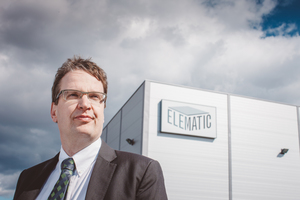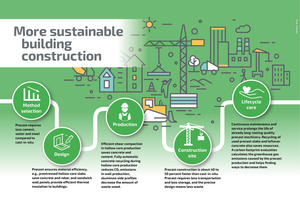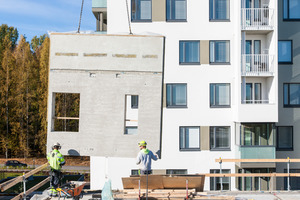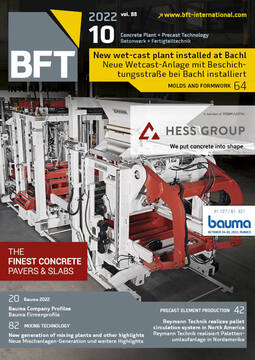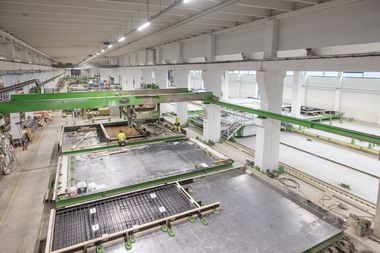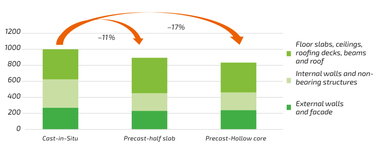The role of precast elements in reducing CO2 emissions
„Factory production of precast concrete can reduce CO2 emissions by 25% and has the potential to save billions of tons of CO2 emissions annually. So why is the issue so neglected?“ asks Mats Jungar, CEO of Elematic.
On the one hand, raw materials for concrete are abundant and the production of concrete foundations and structures is cost-effective. On the other hand, concrete contributes about 8% of global CO2 emissions. There is general consensus that this figure needs to be reduced in order for the world to meet its commitments under the Paris Agreement, COP26, etc. „The problem is that there are no available (and affordable) alternatives to concrete. Replacing concrete with steel, brick or wood is not economical and, if used in the quantities needed worldwide, would cause its own environmental problems. Finland, for example, would have to cut down all the trees in its heavily forested country in just a few years to substitute wood for concrete. So concrete is easy to criticize, but hard to replace,“ Jungar continued.
While efforts are being made to make the concrete supply chain cleaner - such as developing CO2-free steel for rebar, eliminating coal-fired kilns to produce cement clinker, or replacing cement with fly ash, for example - this is unlikely to solve concrete‘s CO2 problem. If someone were to say today that there is a technology that can build concrete buildings with 25 % lower CO2 emissions, hardly anyone would believe it.
Precast elements are the cleaner alternative
The solution could be to build walls and floors not in cast-in-place concrete, but in strictly controlled precast plants. While a floor concreted on site is made of solid concrete, a hollow core floor - with its voids in the core - requires only slightly more than half the concrete. Cement consumption is reduced by a third per m3 of concrete because the compaction process in the plant is much more effective. Even steel consumption is lower because it is prestressed before concreting, so about 10 to 15 kg less steel is needed per m2 of hollow core. And that‘s not all - because the precast hollow core slabs are so much lighter, less concrete is needed for the foundations. It also allows the number of interior load-bearing walls to be significantly reduced.
The list of advantages of using precast concrete elements over cast-in-place concrete is long. The ability to incorporate insulation into the process not only lowers heating costs in winter, but can also dramatically reduce air conditioning costs (and associated CO2 emissions) in hot climates. Scrap is a major problem with on-site concreting - with precast, excess material can be recycled back into the production process. Unlike dry-hot desert climates, where large amounts of water are needed to protect fresh concrete, no additional water is needed in a factory-controlled precast environment.
A breath of fresh air
Pollution is not limited to CO2 - up to 25% of air pollution in major cities is due to dust generated by concrete construction. The production of precast elements offers enormous potential for improving air quality in inner cities. Last but not least, the use of precast floors and walls can reduce construction time by a third.
The fact that the elements are subject to strict quality control and can be lifted and assembled on site (often without scaffolding) improves safety on the construction site and security throughout the life of the building.
„We‘re fixing our house“
„For all its advantages over cast-in-place concrete, precast concrete manufacturing is not perfect, and we are working to improve our own carbon footprint. To this end, we at Elematic have recently met the requirements of the ISO14001 standard, which helps us to improve our environmental performance through more efficient use of resources and waste reduction - and to reduce our own CO2 emissions, thus ‘were fixing our own house’,“ Mats Jungar continues.
Elematic is aware that most of the CO2 emissions generated by precast technology occur during the use phase at the customer‘s site. For this reason, a range of services is offered to help determine a carbon footprint and create action plans to reduce it. Establishing the carbon footprint of a facility is the first step toward low-carbon element manufacturing. To determine the CO2 emissions of a building product, the CO2 footprint of the production process must be known, including the emissions impact of the energy and raw materials used and the CO2 emissions of the concrete elements produced. Detailed reports help determine the most effective ways to reduce carbon emissions from precast plants.
„In our day-to-day work, our mission is to make precast production as efficient as possible - using less material, energy, time - and CO2. At the heart of this modernization technology is process automation and Plant Control, a software suite that combines precast process optimization with the latest IT. We are coming to bauma with a whole range of innovations that help our customers do more with less,“ says Mats Jungar.
Looking to the future, Elematic is also involved in funding the Loikka project, a joint venture that aims to drastically reduce greenhouse gas emissions from the concrete industry. This project will test low-CO2 precast concrete products. The transition to low-emission concrete elements presents precast concrete plants with a productivity challenge: How can production be maintained when low-carbon concrete elements dry more slowly than conventional concrete elements? Elematic‘s customers operate hundreds of factories around the world. If the Finnish equipment manufacturer can help them make the transition to low-carbon concrete, it will have a far-reaching impact on the climate.
Climate protection deserves a higher priority
„So if precast concrete is so good in many ways, why isn‘t it even more popular? Unfortunately, the answer lies in the fact that construction companies usually win tenders if they are the cheapest and not the most environmentally friendly. In addition, no one in the construction value chain is responsible for a building‘s CO2 emissions. Of the major economies, only China promotes the use of precast construction. This is the solution - only new laws and regulations can break the environmentally damaging cycle of choosing cast-in-place concrete. The irony is that cast-in-place concrete‘s reputation for being the cheapest option is not really justified. When you factor in shorter construction times, lower labor requirements, and less waste, precast is quite comparable to cast-in-place concrete construction.
With global warming on the rise, the technology to radically reduce CO2 emissions in concrete construction is available today. We have the relevant know-how. The only question is whether anyone is prepared to take advantage of this opportunity,“ concludes Mats Jungar.

